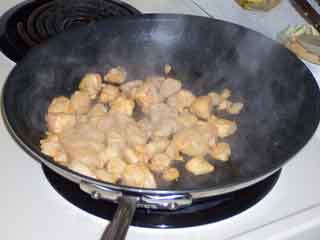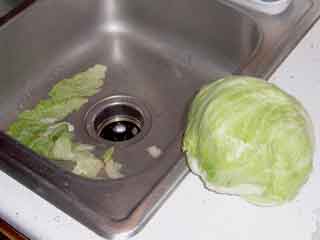here's what you'll need for two big servings. . .
1 large boneless, skinless chicken breast or 4 to 6 chicken ‘tenders’
1 can peas
onion
red bell pepper
garlic
mushrooms
Louisiana Hot Sauce
dried thyme
dried rosemary
paprika
fresh ground Tellicherry
soured cream
wide egg noodles
butter
olive oil

Here's how you do it.
Cube the chicken and massage it with the hot sauce. As I was making this up, I first planned on using SriRacha for the ‘heat’, but maybe that would have been a little too much or too ‘hard’ a heat. Then I thought about Tabasco, but that seemed too ‘pointy.’ sort of a needle-like heat. But then the old stand-by came to mind – Louisiana Hot Sauce – and it just seemed to work perfectly with the piquant pungency of the paprika. So rub it in and let the chicken sit until you get everything else ready (30 minutes or so).
Don’t drain the peas! Instead, season them with some dried thyme and rosemary. Crush about 1/3 tsp. of each in the palm of your hand and toss it into the liquid. Let the seasoned peas, like the chicken, sit for 30 minutes.
Put a pot of water on the stove and crank up the heat. By the time you get the rest of this stuff prepped, the water will be ready to cook your pasta.
I had some little bits of red onion leftover, so I chopped them up. But that didn’t look like enough, so I added about 2/3 of a yellow onion, sliced paper thin. Yeah, that’s about right . . Chop up the red bell pepper; I used about 1/3 of a large one. Chop the garlic. That’s two good-sized cloves, coarsely chopped. And, hey, mushrooms go with everything!
And to provide a cool, crunchy contrast to the goulash, toss together some iceberg lettuce and tomatoes to go with your favorite Ranch dressing.
Now that you can pay attention to the timing, your pot of water should be boiling, so cook up some wide egg noodles. Don’t let them cook for more than 5 minutes! Then drain them, give them a quick rinse under cold water, and back into the still warm pot. Add a Tbsp. or so of butter, stir to coat the noodles and then cover the pot to keep them warm.
Next, remove your skillet from its burner and turn the burner up to medium high (about 3 o’clock on my stove knobs). You don’t want to heat empty non-stick pans that hot – the heat will break down the coating and food will stick forevermore. But you will want to seal the chicken quickly so it will stay tender on the inside while you get it nicely browned on the outside.
So, when the burner is nice and hot, put the skillet on, count to 3, add a couple Tbsp. of olive oil, turn on the exhaust fan, and toss in the chicken. Swirl, toss, flip, and otherwise keep your chicken moving until it’s all nicely sealed. If the heat is right, it should take less than 2 minutes.

As soon as the chicken is sealed, lift the pan off the burner, reduce the heat to medium low (about 7 o’clock), count to 17, put the skillet back on the burner and cook the chicken until it’s brown. Probably another 4 to 6 minutes.

When the chicken is browned, remove it from the pan and set it aside until you get the sauce prepared. Try to leave all the oil in the skillet.
Now, put the skillet back on the burner, crank the heat up again (to about 4 o’clock this time), count to 5 and add the onions. Sauté for exactly one minute.
Add the peppers; sauté 1 minute.
Add the mushrooms; sauté 2 or 3 minutes, just until they begin to change color.
Add the garlic; sauté 1 minute.
Grind fresh Tellicherry all over everything. Stir it all around. Deglaze with white wine (that just means pour a goodly slug of wine into the hot skillet). Let it sizzle until half the wine is gone.
Add the peas and all the seasoned liquid, and swirl it all around until it comes back to a lively simmer.
Add about 3 Tbps. of soured cream and stir to mix thoroughly.

Return the sauce to a gentle simmer, reducing the heat to about 8 or even 9 o’clock on the knob. When the simmering has started, add the first dose of paprika. I just sprinkle my paprika on until it ‘looks right.’ In this case, I’d say I used about 2 Tbsp. It’s a pretty hefty dose.
And speaking of paprika, there are lots of different paprikas out there. Sweet, sour, half-sharp, and probably 27 others I’ve never heard of. I find I really like the flavor of the garden variety McCormick’s brand. Not too sharp, not too sweet, works well with other flavors but holds its own taste when cooked. So I buy it by the barrel and sprinkle it on everything. Your mileage may vary . . . But if you don’t like one brand, do try another and keep trying until you find the one(s) that work(s) for your taste.

OK. Keep that gentle simmer going until the volume of your sauce has been reduced by half. That may take from 5 to 7 or 8 minutes, so stir everything around every minute or two to help the sauce ‘become one.’ Don’t let it boil or your sauce will at least separate, maybe burn.
When the volume is down and the sauce is ‘one,’ add the chicken and more paprika. This time, I used less, maybe a couple of tsps. Once again, I just sprinkle until it looks right.

Cook a while. I don’t know. Until it’s ‘done.’ You want the chicken to get heated all the way through. You want the paprika flavors to have time to permeate the sauce. You want some of the ‘hot’ from the Louisiana Hot Sauce to wander through the dish. Give it 10 to 15 minutes or so; more than 20 or 25 would probably be a bad idea – too much liquid would evaporate.

When it’s ‘done,’ make noodle ring,

fill it with goulash,

and enjoy! Serve it up with your lettuce and tomato salad and maybe some crispy rye toast or crunchy French bread . . .

















